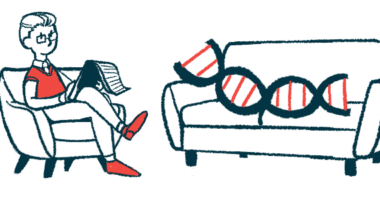First-line gene therapy may offer better sustained results in SMA
Matched-cohort study: Zolgensma yields stronger outcomes in SMA type 1 kids

First-line Zolgensma (onasemnogene abeparvovec-xioi) outperformed first-line Spinraza (nusinersen) in achieving a more sustained clinical response and reducing the need for supportive care among young children with spinal muscular atrophy (SMA) type 1, according to a head-to-head analysis.
Still, both therapies led to comparable, clinically meaningful improvements in motor function and sitting abilities, the data showed.
“The findings support consideration of [Zolgensma] as a potentially preferable treatment option in SMA type 1 and may offer evidence to guide treatment decisions,” the researchers wrote in the study, “Comparative Clinical Outcomes of Nusinersen and Gene Therapy in Spinal Muscular Atrophy Type 1,” published in JAMA Network Open.
Approved SMA therapies designed to boost missing protein level
Spinraza and Zolgensma are two disease-modifying therapies (DMTs) approved for people with SMA, an inherited neuromuscular disorder marked by progressive muscle weakness. Both are designed to boost the levels of SMN, the protein that’s deficient in those with SMA due to genetic defects.
More countries are adopting SMA newborn-screening programs to support early diagnosis and treatment, but there’s still limited information on which therapy should be used first.
To learn more, researchers collected data from the French National SMA Registry to compare clinical outcomes of first-line Spinraza or Zolgensma therapy in children with SMA type 1.
The study included 24 children with SMA type 1 who were already showing symptoms of the disease. Half were treated with Spinraza and half with Zolgensma. Eligible participants were those who received treatment within six months of diagnosis and had at least two years of follow-up.
To make the comparison fair, the researchers matched the two groups based on age, breathing and nutritional status at the start of treatment, and motor function before treatment, as assessed by CHOP INTEND scores.
Zolgensma group needed less supportive care during two years of follow-up
Within the first year of treatment, three children died due to respiratory complications attributed to disease severity rather than treatment-related or side effects.
After a two-year follow-up, children treated with Spinraza required more breathing and nutritional support than those given Zolgensma.
Nearly twice as many children in the Spinraza group needed nighttime breathing support (80% vs. 45%). Only those treated with Zolgensma were weaned off breathing assistance — two children compared with none in the Spinraza group.
The need for nutritional support was more than five times higher among children taking Spinraza (50% vs. 9%). Two of these children developed severe bulbar muscle weakness in the face and throat that prevented oral feeding or swallowing saliva.
Both treatment groups showed comparable motor improvements. All children achieved a clinically important increase of at least 4 points in CHOP INTEND scores. The rate of motor improvements over time did not differ between Zolgensma and Spinraza (0.82 vs. 1.15 points/month).
All surviving children were able to sit with support after two years. Independent sitting was achieved by every child treated with Zolgensma and by nearly all (90%) of those given Spinraza.
The findings support consideration of [Zolgensma] as a potentially preferable treatment option in SMA type 1 and may offer evidence to guide treatment decisions.
Researchers next compared both therapies using a measure called an unsatisfactory clinical response (UCR). This is a combined assessment of death, treatment switch (or add-on, in the case of Zolgensma, which is given one-time) due to inadequate response, initiation of feeding support, and/or failure to sit independently.
Nearly three times more children taking Spinraza achieved a UCR than those given Zolgensma (67% vs. 25%), which “highlights the challenges of achieving sustained efficacy in some patients [with Spinraza],” the team noted.
After two years, two children in the Zolgensma group received an add-on therapy because of insufficient motor improvement — one received Evrysdi (risdiplam) after three years, and the other Spinraza after two years. In the Spinraza group, half (50%) switched to Evrysdi between about two and six years after their initial treatment, primarily due to bulbar deterioration or a lack of motor improvement.
“The findings may help inform first-line treatment choices in this rare and severe disease,” the researchers concluded. “For other SMA [types], the decision between [Zolgensma] and [Spinraza] should remain a shared process that carefully balances the benefits and potential burdens of each approved therapy.”
They added that “future studies targeting presymptomatic infants treated within a narrow therapeutic window are needed to refine treatment recommendations in newborn screening programs.”








